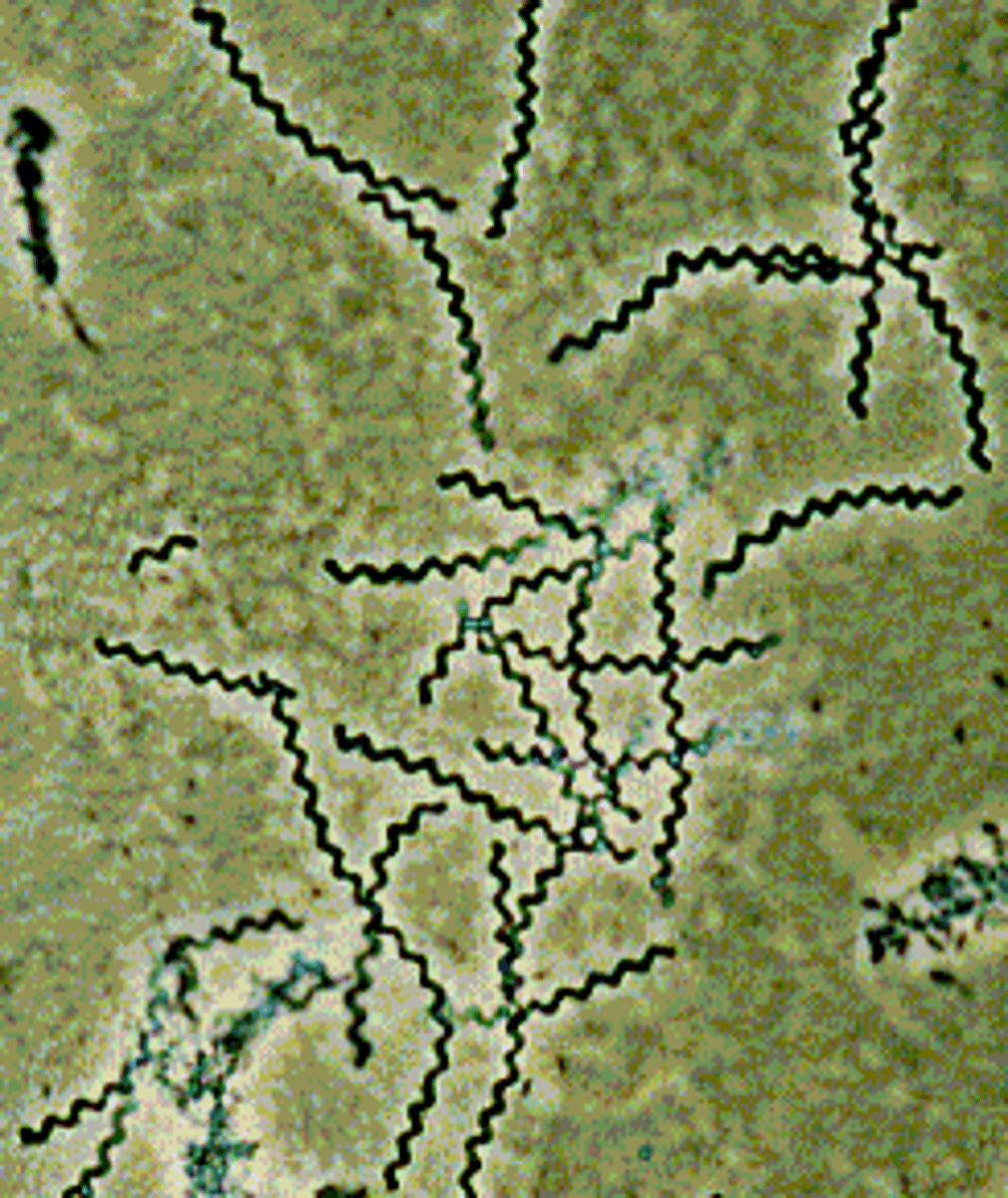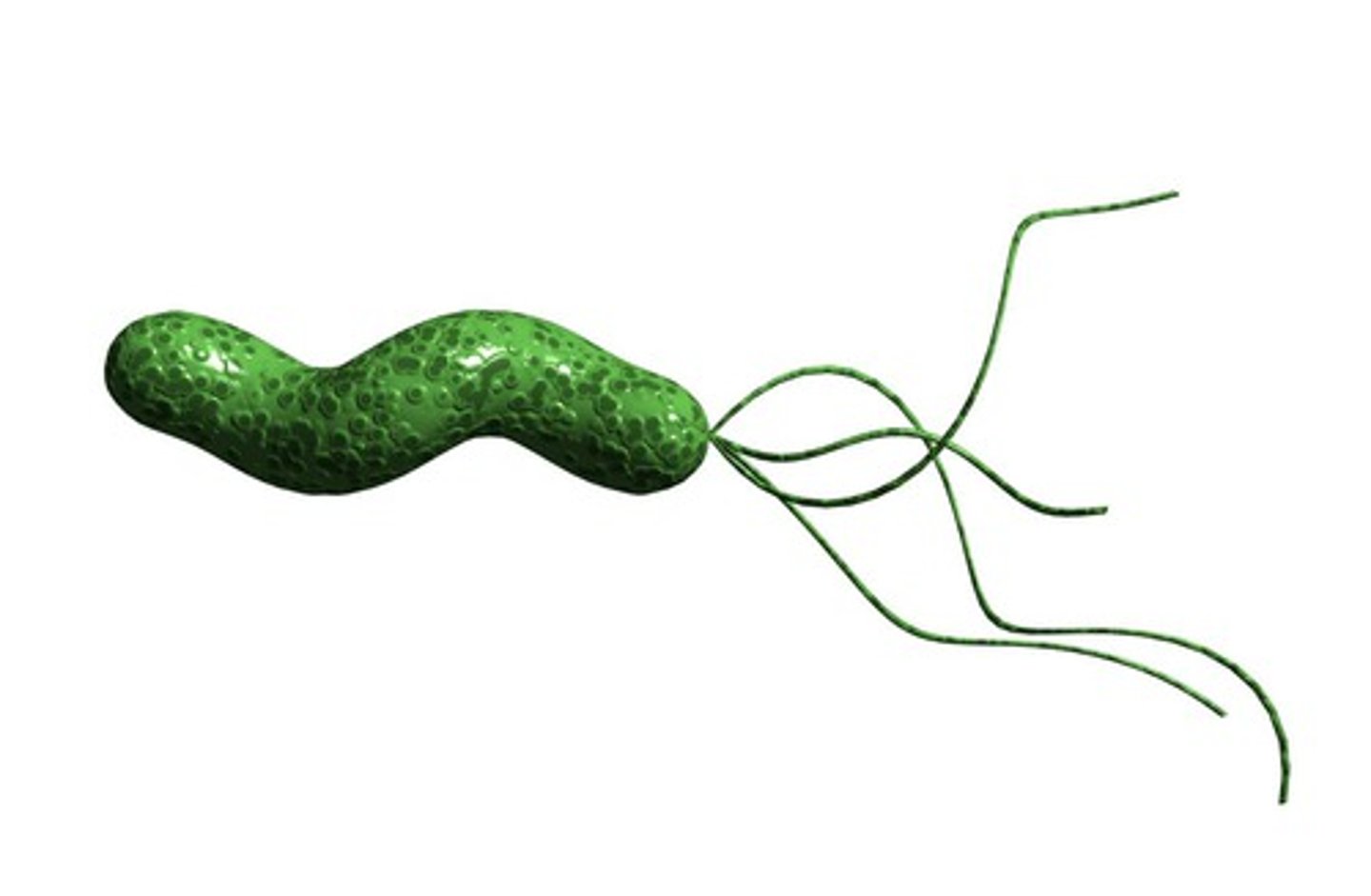17- Campylobacter and Helicobacter
1/19
There's no tags or description
Looks like no tags are added yet.
Name | Mastery | Learn | Test | Matching | Spaced |
|---|
No study sessions yet.
20 Terms
Spirochetes
spiral-shaped bacteria
-Tightly coiled, helically-shaped bacteria
-Very thin; must use Darkfield microscopy to see
-Gram-negative cell walls with flagella in the periplasmic space (endoflagella or axial filaments)
-Most spirochetes are non-pathogenic
-Move in a corkscrew fashion through their environment

Five genera with spirochete species that can cause human disease
-Campylobacter
-Treponema
-Leptospira
-Helicobacter
-Borrelia
Campylobacter
Tiny, gram-negative, flagellated, comma, spiral, or s-shaped bacteria
-50+ species identified; only four are common human pathogens (C. jejuni, C. coli, C. fetus, and C. upsaliensis)
What is bacteria is the most common of bacterial gastroenteritis in the U.S.?
Campylobacter jejuni
What type of atmosphere does Campylobacter jejuni grow best in?
Low O2 (5-7%) and increased CO2 (5-10%) atmosphere.
What is a common source of Campylobacter jejuni infection?
Ill-prepared poultry.
-zoonotic infection
Virulence factors of C. jejuni
-Anti-phagocytic polysaccharide capsule
--LPS with endotoxin is absent in these gram-negative bacteria
-Adhesions, cytotoxic enzymes, and enterotoxins (poorly defined role)
Campylobacter jejuni
Risk of disease is influenced by the infectious dose of C. jejuni
-Dose required to establish disease is high
-Susceptible to gastric acid
-Previous exposure provides partial immunity
-Person-to-person spread is unusual
Where and how does C. jejuni produce damage in the body?
C. jejuni disease produces damage to the mucosal surfaces of the jejunum, ileum, and colon
-Hyperactivation of immune cells and cytokine storm
-Disease pathogenesis is related to antigenic-cross-reactivity
Clinical presentation of C. jejuni
Gastroenteritis = Damage to mucosal surfaces of the jejunum, ileum, and colon
-acute enteritis with diarrhea, fever, and sever abdominal pain
-Can mimic acute appendicitis (particularly in children/ young adults)
Guillain-Barre Syndrome = Autoimmune disorder of peripheral nervous system
-Well-recognized complications of Campylobacter infection
-Symmetrical weakness/tingling in extremities are usually the first symptoms
-Difficulty swallowing, shortness of breath, and flaccid paralysis in advanced disease
Reactive arthritis = Characterized by joint pain and swelling of the hands, ankles, and knees
-can persist from one week to several months
Treatment of C. jejuni
Gastroenteritis is self-limiting; severe cases treated with erythromycin and azithromycin
-Spread of bacteria reduced by proper food handling and preparation
Helicobacter
Tiny, gram-negative, flagellated, slightly helical bacteria
-Discovered in 1983 and originally classified as Campylobacter
-Subdivided into two groups: Gastric Helicobacter and Enterohepatic helicobacter

Helicobacter pylori
Gastric Helicobacter associated with gastritis, peptic ulcers, gastric adenocarcinoma, and gastric mucosa-associated lymphoid tissue (MALT) B-cell lymphoma
-Ubiquitous worldwide; Humans are the primary reservoir
Virulence factors of H. pylori
-Urease (+ammonia and bicarbonate by-products)
-Mucinase, phospholipase, and vacuolating cytotoxin A (VacA)
How does Helicobacter pylori initially colonize the stomach?
Initial colonization is facilitated by blockage of acid production and neutralization of gastric acids.
What substance is produced by Helicobacter pylori's urease activity?
Ammonia.
How does Helicobacter pylori attach to gastric epithelial cells?
H. pylori migrates through gastric mucosa and attaches to gastric epithelial cells with adhesion proteins.
What causes localized tissue damage in Helicobacter pylori infections?
Localized tissue damage is caused by urease byproducts, mucinase, phospholipases, and the activity of vacuolating cytotoxin A.
Clinical presentations of H. pylori
Gastritis = inflammation of gastric mucosa; can become chronic
-Characterized by feeling full, nausea, vomiting, and hypochlorhydria (decreased acid production)
Peptic ulcers = ulcers develop at sites of intense inflammation
-Gastric ulcer- Junction between the corpus and antrum
-Duodenal ulcer - Proximal duodenum
Gastric adenocarcinoma = Progression of chronic gastritis to stomach cancer
MALT B-cell lymphoma = Development of a monoclonal population of B-cells
Treatment for H. pylori
-Combined therapy with a proton pump inhibitor (omeprazole), bismuth, tetracycline, metronidazole, or clarithromycin for two weeks has high success
-Recommend only treating symptomatic patients; prophylactic has adverse effects